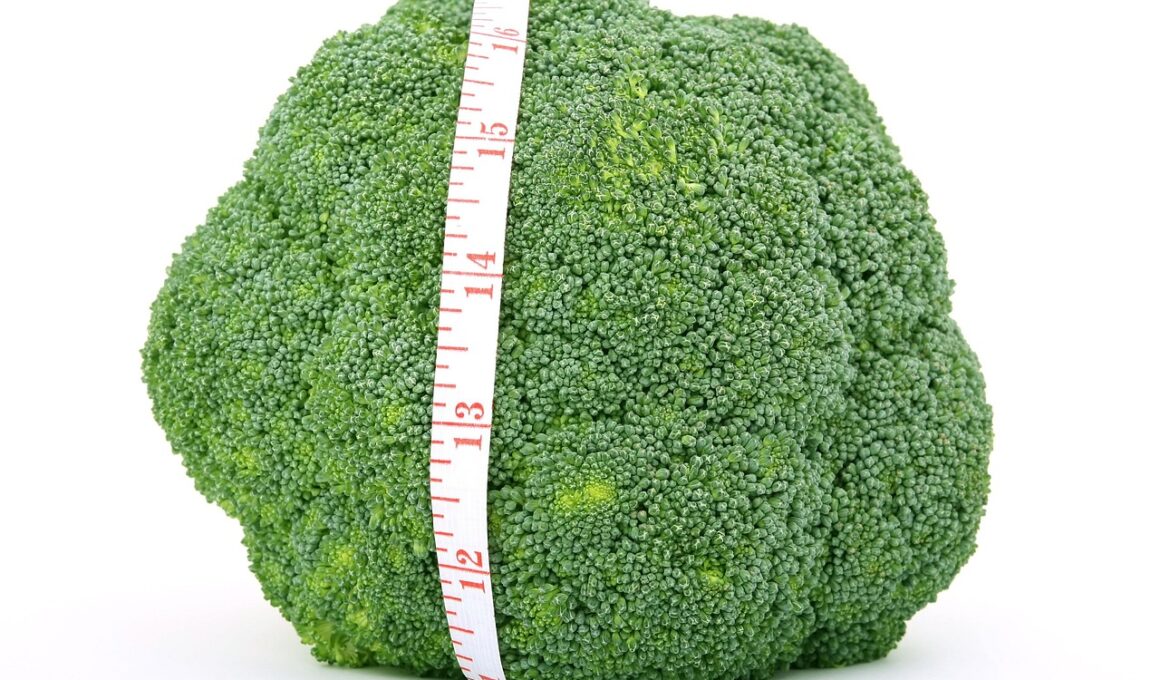The Link Between Fiber Intake and Reduced Calorie Consumption
The significance of fiber in a balanced diet cannot be understated, especially regarding weight maintenance and overall health. Fiber, a type of carbohydrate found in plant-based foods, is important as it contributes to satiety. When individuals consume fiber-rich foods, they tend to feel fuller for extended periods. This feeling of fullness can significantly lower calorie intake by reducing overall hunger. Foods high in fiber often have lower calorie densities, providing volume without excessive calories. Thus, replacing lower-fiber foods with fibered options helps manage appetite and control calorie consumption more efficiently. Different forms of fiber, such as soluble and insoluble, play unique roles. Soluble fiber can slow digestion, while insoluble fiber adds bulk to stool, promoting regularity. Including a variety of fiber sources, like fruits, vegetables, whole grains, and legumes, is essential for optimal benefits. Moreover, fiber has additional advantages, such as improving gut health, regulating blood sugar levels, and lowering cholesterol levels. In summary, fiber intake is a strategic component for those aiming to maintain a healthy weight without experiencing constant hunger or cravings.
Incorporating fiber into daily meals can transform dietary habits and lead to sustainable results. Fiber is particularly abundant in whole foods, making them a great choice for individuals pursuing weight maintenance. For instance, foods like oats, barley, beans, lentils, psyllium, and chia seeds are excellent fiber sources. Including these foods in meals can be as simple as substituting traditional grains with whole grains or adding beans to salads. Moreover, fruits and vegetables provide an incredible variety of options to choose from. By introducing more plant-based foods into your diet, you not only increase fiber intake but also enhance nutritional value overall. This can contribute to better health and lower calorie consumption while still feeling satisfied. Those looking to achieve their weight maintenance goals should track fiber intake through simple dietary adjustments. Gradually increasing fiber consumption can help avoid digestive discomfort while ensuring sustainable weight management. The positive effects of fiber on general health create a holistic approach to weight maintenance, making it easier to sustain. It’s essential to drink plenty of water alongside a fiber-rich diet to ensure digestive systems function optimally.
Types of Fiber and Their Importance
Understanding the different types of fiber is vital for optimizing its benefits, particularly in weight maintenance strategies. Dietary fiber is primarily classified into two categories: soluble and insoluble fiber. Soluble fiber dissolves in water and forms a gel-like consistency in the stomach, offering a sense of fullness. Foods containing soluble fiber, such as oats and apples, are effective for smoothing digestion. This digestion slowdown results in a more gradual release of glucose into the bloodstream. On the other hand, insoluble fiber does not dissolve in water and adds bulk to digestive contents. Entire grains, nuts, and vegetables offer insoluble fiber, promoting regular bowel movements. Both types of fiber contribute to calorie reduction through their unique effects on digestion and hunger. Including a wide variety of both types enhances your diet and maximizes health outcomes. It’s important to recognize that different fibers interact with the gut microbiome distinctively, influencing metabolic pathways. Thus, understanding fiber diversity can aid in effective meal planning. By prioritizing fiber-rich foods, individuals can create a balanced diet that supports weight maintenance while fulfilling essential nutrient requirements.
Adopting healthy eating habits and being mindful of one’s fiber intake can lead to significant benefits, including improved metabolic health. Research suggests that individuals with sufficient fiber consumption tend to maintain healthier body weights and enjoy a lower risk of obesity-related conditions, such as diabetes and cardiovascular diseases. These associations highlight the potential long-term benefits of a high-fiber diet. Individuals can strategize their approaches to fiber intake by experimenting with various high-fiber foods and recipes. Incorporating legumes, fruits, nuts, and whole grains can transform typical meals into fiber powerhouses. For example, replacing white rice with quinoa or adding beans to a salad can amplify fiber content dramatically. Exploring innovative ways to integrate fiber into dietary routines encourages mindful eating practices and can help develop new taste preferences. Notably, fiber has a positive influence on gut health by promoting the growth of beneficial bacteria. Thus, sustaining high-fiber consumption can deliver benefits beyond weight management. Involving whole, minimally processed foods in meal preparations can further support this aim and contribute to lasting wellness improvements.
Strategies for Increasing Fiber Intake
To effectively boost fiber consumption, individuals can utilize multiple strategies that align with their lifestyles and preferences. One effective approach is to gradually increase fiber intake to mitigate digestive discomfort and ensure proper adaptation. It can also be beneficial to read nutrition labels and look for foods with at least 3 grams of fiber per serving. This simple habit can help shoppers make informed choices while grocery shopping. Moreover, exploring various recipes and trying new food items can make increasing fiber enjoyable and appealing. Incorporating snacks like fresh fruits, cut vegetables with hummus, or whole-grain crackers can help bridge the gap between meals. Planning meals around high-fiber ingredients encourages innovation in the kitchen and sparks enjoyment in cooking. Opting for whole fruits instead of juices or blending smoothies with leafy greens can provide essential nutrients without adding excessive calories. Furthermore, integrating fiber-rich foods into breakfast routines, such as oatmeal topped with berries or avocados on whole-grain toast, can set a positive tone for the day. Overall, incorporating fiber supports weight maintenance while expanding the palate and nourishing the body.
Understanding the effects of fiber on reduced calorie consumption promotes healthier lifestyle habits. As fiber-rich foods are often less calorie-dense compared to processed alternatives, they encourage users to choose healthier options. Aside from their role in appetite control, fiber-rich foods also stabilize glucose levels, thereby reducing cravings and subsequent caloric intake. Research identifies a clear connection between high-fiber diets and reduced calorie consumption, as individuals feel fuller longer. Furthermore, as gut health improves with fiber intake, the body can better regulate metabolic processes. This dynamic can further enhance weight maintenance efficacy. Regularly consuming fiber leads to a stable energy supply without sudden spikes, favorably impacting mood and eating behaviors. The supportive role of fiber in weight maintenance establishes a comprehensive approach to nutrition. Recognizing that satiety depends not just on calories but also on the quality of food helps shift priorities toward whole food choices. Even among meals that may seem calorie-rich, high-fiber ingredients make a significant difference in moderation. This holistic understanding allows for flexibility in meal planning and promotes a healthier relationship with food.
The Final Takeaway on Fiber and Weight Maintenance
Ultimately, fiber plays an indispensable role in supporting weight maintenance and overall health. Understanding how various fibers interact with appetite regulation is essential for making mindful dietary choices. Efficient weight management is less about strict calorie counting and more about nourishing the body with wholesome foods. By prioritizing high-fiber options, individuals can cultivate sustainable relationships with food. Regularly incorporating beans, nuts, seeds, fruits, and vegetables contributes to improved health outcomes. Moreover, education on the benefits surrounding fiber empowers individuals to make informed decisions about their diets. With the right knowledge and strategies, embracing better eating habits becomes an achievable goal. Sustainability in fiber intake leads to enhanced metabolic health, psychological well-being, and overall longevity. Consequently, as individuals navigate their weight maintenance journeys, the insightful relationship between fiber intake and reduced calorie consumption becomes paramount. By adopting high-fiber dietary habits, not only can individuals experience effective calorie management, but they will also attain broader health benefits that contribute to lasting wellness. Embracing fiber is more than a strategy; it is investing in personal health for years to come.
The more we learn about the impact of our dietary choices, the clearer the importance of fiber becomes. The range of benefits it provides is extensive and multifaceted. Individuals committed to weight maintenance can leverage fiber’s advantages in practical and actionable ways. As we have seen, choosing fiber-rich foods leads to fullness, improved digestion, and better metabolic health. It’s essential to remember that incorporating fiber into everyday meals can be a delightful adventure, transforming the dietary experience. With creativity and experimentation, healthy eating will become not just a goal, but a fulfilling lifestyle commitment. Establishing smarter eating habits correlates directly with reduced calorie consumption and weight maintenance strategies, reinforcing the importance of fiber in modern diets. As we advocate for fiber, we encourage a movement towards healthier living that prioritizes nourishing food choices and long-term wellness.


